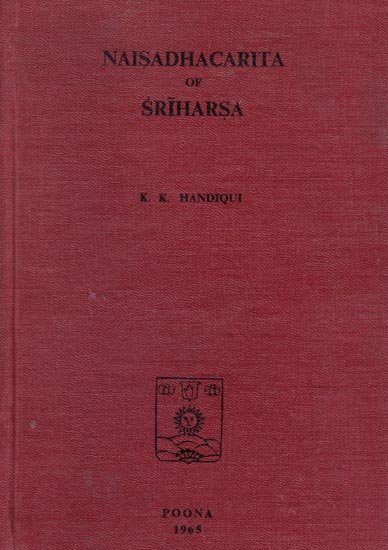Naishadha-charita of Shriharsha
by Krishna Kanta Handiqui | 1956 | 159,632 words
This page relates Preface to the second edition of the English translation of the Naishadha-charita of Shriharsha, dealing with the famous story of Nala (king of Nishadha) and Damayanti (daughter of Bhima, king of Vidarbha), which also occurs in the Mahabharata. The Naishadhacharita is considered as one of the five major epic poems (mahakavya) in Sanskrit literature.
Preface to the second edition
The Translation has been revised and additions made to the Notes, Appendices and the Vocabulary.
Soon after the publication of the first edition Dr. A. K. Coomaraswamy informed me that the Nala-Damayantī series of drawings of the Kangra School closely followed the text of Śrīharṣa’s Naiṣadhacarita. A copy of his magnificent Catalogue of Rajput paintings in the Museum of Fine Arts, Boston, was sent to me for examination; and in a note published in The Indian Historical Quarterly, Vol. XII, 1936, I pointed out some of the episodes in the Naiṣadhacarita on which the paintings were based. Dr. Coomaraswamy seems to have read the Translation with care and made some suggestions which I have adopted in the present revision.
I owe an apology to the learned public for the unusual delay in publication of the work mentioned in the Introduction. Other studies and responsibilities have been the main factors in retarding the progress of this undertaking of my younger days. But I hope that the work will be completed and published before long at least in a modified form.
The ungrudging help of my friend Dr. P. K. Gode of the Bhandarkar Oriental Research Institute, which I gratefully acknowledged in the Preface to the first edition, has been generously repeated after the lapse of so many years; and he has taken the trouble of preparing for me summaries of certain Marathi materials in connection with the detailed Footnote on the Dattātreya sect in Appendix II.
It is a happy augury that the compilation of a comprehensive Dictionary of the Sanskrit language on critical and historical principles about which I expressed a vague hope in the Preface to the first edition has been undertaken by the Deccan College Postgraduate and Research Institute. I thank the authorities of the Institute for including the Translation in their Monograph Series and specially for their kind acceptance of the present edition as a gift to be utilized in furtherance of the work on the Dictionary project.
K. K. Handiqui
Gauhati,
1956
